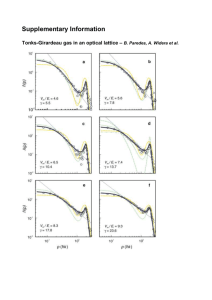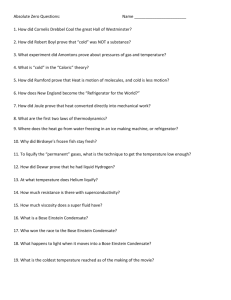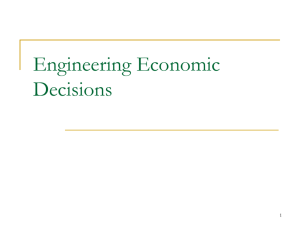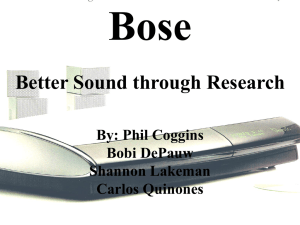EIS_Mini_Project_McGrath_Fraser_Bose_Auto_Suspension_vfinal
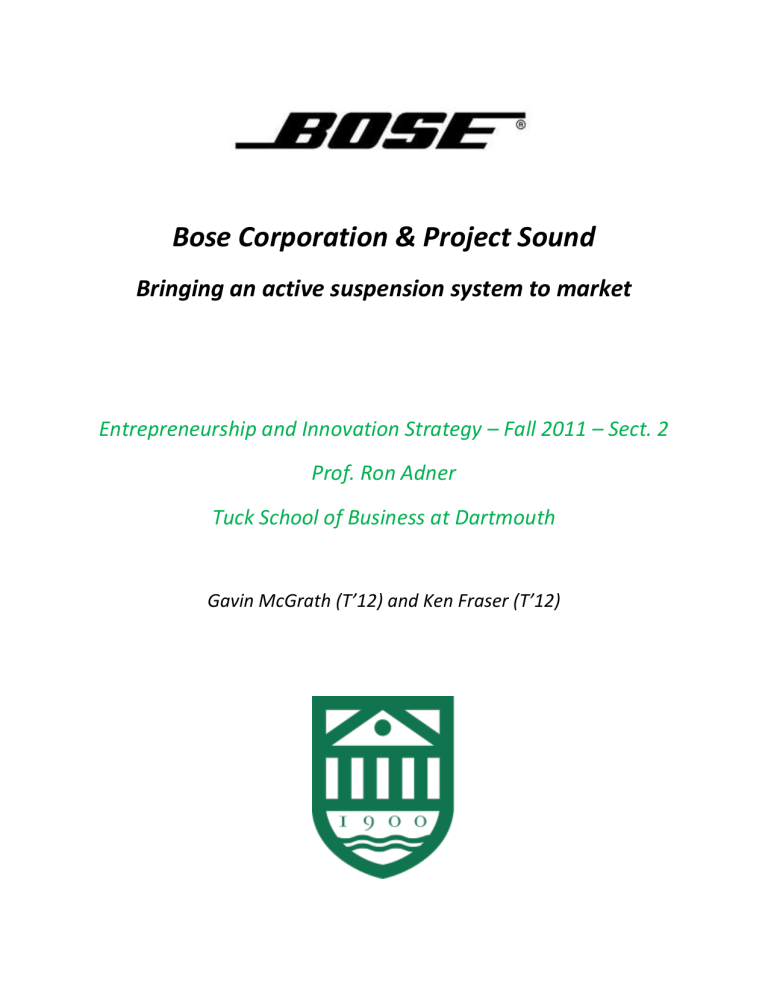
Bose Corporation & Project Sound
Bringing an active suspension system to market
Entrepreneurship and Innovation Strategy – Fall 2011 – Sect. 2
Prof. Ron Adner
Tuck School of Business at Dartmouth
Gavin McGrath (T’12) and Ken Fraser (T’12)
0
"Car manufacturers who see this can see that this is the future of vehicles" i
Neal Lackritz, Lead engineer, Project Sound, Bose Corporation – December 2005
“When will it be ready? In 1990, I said two years. Within the next six to ten months,
I'll be in a position to select a manufacturer, only one, to team with” ii
INTRODUCTION
Dr. Amar Bose, Founder and Chairman, Bose Corporation – February 2009
After nearly three decades of research, testing, and meetings with automotive executives from companies such as Toyota, General Motors, and Nissan, the Project Sound engineering team looked up at the project’s lead engineer, Neal Lackritz as he approached the microphone in the company’s auditorium. Lackritz stood on stage alongside Bose’s president, Bob Maresca, Jim Parison, Principal
Engineer from the R&D division, as well as the firm’s 79 year old founder and chairman, Dr. Amar Bose, to celebrate the manufacture of the first Bose suspension system to roll off the assembly line. On the large screen above the stage, live video streamed from the Park Place manufacturing facility, just down the street, showing the completed product being placed in its corrugated packaging and sealed for shipping. As the audience cheered, the four men on stage smiled enthusiastically. But in the back of their mind, they each wondered if there could have been an easier path to this starting line.
PROJECT SOUND
Dr. Amar Bose first contemplated the notion of perfecting an auto suspension in 1957 when he purchased a ’58 Pontiac Bonneville with an air suspension system. “I spent as much time under the car as I did in the driver's seat,” recalls the octogenarian inventor.
iii As years passed, however, Dr. Bose turned his attention to the field of psychoacoustics – the scientific study of the perception of sound – and began to develop the loudspeaker technologies that would make him famous. It wasn’t until 1980 that Dr. Bose formed an automotive suspension research group at his namesake U.S. company, Bose
Corporation, in Framingham, MA outside Boston. The purpose of this group was simply stated: to create a vehicle suspension that could combine the comfortable ride of a luxury vehicle with the nimble handling of a sports car.
iv This is considered the Holy Grail by car industry insiders because it enables the driver to avoid purchase tradeoffs between a Porsche and a Mercedes, for instance, and could even let the drive choose the type of ride he feels.
1
COMPANY BACKGROUND
That Dr. Bose was thinking about the mathematics of an optimal auto suspension is still surprising to those who know the inventor for his decades of accomplishments. Bose Corporation made its name creating new methods and products to better reproduce recorded sound. Today, however,
Bose is a vertically integrated electronics company with businesses ranging from military and consumer headphones to home audio systems and medical testing devices. Founded by Dr. Bose in 1964, Bose
Corporation is privately owned and prides itself on reinvesting 100% of its profits back into its research and development activities.
ACTIVE SUSPENSIONS
The notion of an active suspension was not unfamiliar to the automotive world. Instead of relying on springs or other types of shock absorbers to reduce the vibration and bumps of the road surface, active suspensions react to bumps by moving the vehicle’s wheel to meet the change in surface grade. Auto manufacturers such as Lotus, Infiniti, Toyota, Volvo, General Motors and Mercedes, as well as component manufacturers such as Delphi and Michelin, had each introduced a quasi-active suspension concept in the past two decades.
v But none had a design as universally praised or successful as that which Bose developed. The key to Bose’s top secret system – code named Project
Sound as a tongue-in-cheek reference to the company’s legacy – was the use of electromagnetic actuators, which had the capability to move each vehicle wheel independently. After Dr. Bose spent five years to determine the algorithms necessary to adequately respond to instant changes in road surface, the Bose engineering team set out to apply its knowledge in loudspeaker drivers to bring Bose’s model to life. Loudspeakers create sound by using magnetic movement to push waves of air at specific frequencies. It is often stated that these underlying concepts, combined with Bose’ research in noisecancellation, are the basis for the Bose active suspension. The firm demonstrated keen awareness of the challenges ahead when it set out to develop the product. A white paper produced to introduce the project to the public in 2004 explains how Bose mitigated co-innovation risk during development:
T HE B OSE S USPENSION R EQUIRED S IGNIFICANT A DVANCEMENTS I N F OUR K EY D ISCIPLINES :
L INEAR E LECTROMAGNETIC M OTORS , P OWER A MPLIFIERS , C ONTROL A LGORITHMS , A ND C OMPUTATION
S PEED .
B OSE T OOK O N T HE C HALLENGE O F T HE F IRST T HREE D ISCIPLINES , A ND B ET O N
D EVELOPMENTS T HAT I NDUSTRY W OULD M AKE O N T HE F OURTH I TEM .
vi
2
Even after 24 years to reach a potentially viable product for commercial application, the biggest challenge, product adoption, was yet to come.
THE AUTOMOTIVE ECOSYSTEM
Once the Project Sound team had produced the performance expected by Dr. Bose, the firm set about introducing the product to members of the automotive industry. By 2005 the firm was conducting open air demonstrations of a retrofitted Lexus LS400 in the company parking lot for CEOs of leading car manufacturers. The demonstration was compelling (See Exhibit 4) but the excitement of a car that could glide over a pothole without the slightest impact for the driver was not translating into any sales.
In fact, by 2009, a single product had not yet been sold. The issue at hand was one familiar to many in the automotive supplier market: the adoption chain. (See Exhibit 1)
Exhibit 1 – Project Sound Ecosystem Map
Auto Ecosystem - Project Sound
INTERNAL
EXTERNAL
CRITICAL
PARTICIPANT
ADOPTION
INFLUENCER
END
CUSTOMER
Physical Flow
Influence Flow
Linear
Electromagnetic
Motors
Power Amplifiers
Control
Algorithms
Bose
Active Suspension
Car Manufacturer
(customer)
Driver
(End User)
On-Board
Computing
Suspension
Manufacturers
Mechanics
Suppliers Innovation
Regulators
Adoption Chain
Time
3
Even though the product was easily retrofitted to existing OEM automobile designs, and car enthusiasts were eager for the improved technology, manufacturers were not stepping up to accept
Bose’s offer for first to market exclusive in the luxury car segment. The sentiments of one competitor,
Aly Badawy, vice president at Livonia, Michigan auto-parts maker TRW Automotive, summed up the challenge Bose faced: “Technically, on paper, I think it's brilliant. The problem is: is it going to be affordable?” vii The OEMs did not seem prepared accept the higher cost of the system, estimated to be
$5,000 as of 2005 according to accounts at the time.
Bose faced multiple challenges across the required adoption chain. Value proposition aside, the major risk for any OEM was safety: having experienced the Ford Explorer saga, the risk of potential damage to their brand and the future of their organization from a major safety issue resulting from the introduction of an untested suspension technology was unacceptable. This was compounded by what they viewed as a marginal value proposition – $5,000 was not an insignificant cost addition, even for a luxury cost manufacturer. Furthermore, OEMs had concerns about chassis integration ease and packaging flexibility, and expected to consider introduction of this type of “by wire” technology only after widespread adoption of complementary safety features, such as FlexRay viii . (See Exhibit 9.)
A major issue for automotive parts suppliers, such Michelin, is the inability to go direct-toconsumer. For Michelin’s revolutionary PAX system, the tire could not easily be retrofitted. This was unfortunate, since successful penetration of the aftermarket channel can pave the way for integration into new builds, as on-the-road experience reduces OEM risk. The Bose suspension system could be retrofitted, yet it was nevertheless unable to penetrate the direct-to-consumer channel. This failure had two sources: first, at $5,000 plus labor, this aftermarket improvement would be affordable only to luxury car drivers, a customer base with a low propensity for vehicle improvement and a high propensity for using OEM-controlled service centers; second, the high geographic dispersion and relatively low mobility of the personal car customer base meant that an extensive network (including lots of related capital expenditure, car garage space commitment, and staff training) would be necessary to support a reasonable volume of sales.
In summary, it was impossible to convince luxury car OEMs to adopt the Bose suspension system because of the organization-wide safety risk and the marginal value proposition; impossible to convince luxury car owners to make significant aftermarket improvements; and impossible to convince a the required broad network of car mechanics to devote valuable garage space and training time to support widespread adoption through the direct-to-consumer market.
4
A COURSE CORRECTION WITH BOSE RIDE®
Recognizing its uphill battle in the consumer vehicle ecosystem, Bose signaled as early as 2006 that it might need to consider alternative niches for its technology where adoption would be more straightforward. In a nod to Bose’s history selling audio equipment for military aviation and ground transport, Neal Lackritz suggested to reporters in 2006 that the firm was considering “military vehicles to make a soldier's ride across a rocky dessert less tiresome.” ix But another source of inspiration struck the Project Sound engineers: Bose’s own over-the-road trucking fleet. Class-8 trucks, the type of big rig commonly seen on North American highways, carried 8.8 billion tons of freight, or 68% of all freight tonnage transported domestically in the United States in 2009, according to The American Trucking
Association.
x The industry also collected nearly 82% of all revenue earned by domestic transport methods.
xi Two of the most important issues facing the trucking industry are driver efficiency, and its corollary, driver fatigue and health. As Bose engineer Jim Parison began exploring alternative uses for the Project Sound technology, he soon realized that the engineering team had embarked on their original journey with the wrong value proposition. Where the initial suspension concept had a top-end luxury benefit that was difficult to quantify, Bose’s own logistics department could see significant potential in the quantifiable health, safety, and efficiency benefits for its truck drivers.
The next challenge to overcome was the complication of adoption that plagued the initial concept. (See Exhibit 2). Engineering’s solution was a self-contained suspension system that could mount under a specially designed driver’s seat. This configuration, called the Bose Ride® system, could be installed aftermarket by a trained mechanic in roughly two hours and was adjustable to fit 95% of the driver population, in terms of height.
xii The cost to the customer was $5,995 excluding applicable sales tax and installation fees and the seat was made available for direct sale to truck owner/operators or fleet owners looking to make volume purchases.
Interested customers were asked to schedule an installation at one Bose’s Framingham headquarters or at authorized installers in Michigan, Texas, Tennessee, or Arizona. To help grow this base of installation outlets, Bose asked drivers for recommendations of trucking centers with high quality customer service and technical expertise. The company also sought real-world feedback on the product via road trials with 77 test drivers.
5
Exhibit 2 – Bose Ride® Ecosystem Map
Trucker Ecosystem – Bose Ride®
INTERNAL
EXTERNAL
Linear
Electromagnetic
Motors
Power Amplifiers
Control
Algorithms
Bose Ride system for heavyduty trucking
CRITICAL
PARTICIPANT
ADOPTION
INFLUENCER
Bose Ride installation center
Certified Bose Ride
Installation Partners
On-Board
Computing
Drivers
POTETIAL
CUSTOMER
END
CUSTOMER
Physical Flow
Influence Flow
Owner/Operators
(Customer)
Fleet Owners
(Customer)
Suppliers Innovation
Truck Manufacturer
(Potential Customer)
Adoption Chain
Time
This feedback, as well as the testimonials that followed, were helpful for the Bose marketing team responsible for convincing road-weary truckers that there actually was a solution for “trucker butt,” the numbing sensation that most drivers grow accustom to after hours of hard-vibration while driving.
Surprising comments and video of over-the-road drivers was captured to make Bose’s claims credible with other drivers:
“My back hasn’t bothered me since I got the seat. That’s the greatest thing. I just turned 52 years-old last week and my bladder isn’t what it used to be. I used to have to stop every two hours at
least, and now I can drive across the state and not have to stop.”
The benefits of the system extended far beyond the comfort value proposition of the original auto suspension. Now, Bose was able to quantify the reduction of driver fatigue due to road-wear. This in turn meant quicker (and safer) transport times as well as reduced workers compensation claims and
6
health care costs for drivers. For trucking fleet owners, this meant higher revenue potential and lower costs.
THE DISTANCE BETWEEN INITIAL EXPECTATIONS AND FINAL OUTCOMES
Initial expectations within Bose were that this product would revolutionize suspension systems in the car industry. In an interview as late as 2005, project leader Neal Lackritz stated that Bose expected to select an OEM partner imminently, and that its product was the future of motor vehicles.
Due to the ease of integration with existing systems (including the ability to retrofit the product) and Bose’s internally focused R&D efforts, co-innovation risk was low relative to other revolutionary products. However, adoption chain risk proved a significant challenge and resulted in a change of tack.
Annual luxury car sales in the US average around 1.25 million each year xiii . If Bose had achieved a 20% share of that market with its revolutionary technology, holding its average selling price of $5,000 per unit, annual sales would have been $1.25 billion (excluding aftermarket sales), nearly doubling the firm’s top line.
By comparison, there are 13.5 million trucks on the road in the US xiv , with annual sales of around
192,000 units. With a stronger economic value proposition and a more disparate decision making base that is amenable to aftermarket improvements (82% of trucks are owned by operators with fewer than six trucks) Bose was better positioned to drive adoption in this market. If 10% of new trucks were to include the seat suspension technology, and even 2% of existing truckers were to adopt each year, Bose could achieve annual sales of $1.74 billion at its proposed selling price of $5,995 per unit.
The new market for truck seats may have been less obvious to Bose, but its potential is nevertheless substantial. Further, the clear economic value proposition and more fertile adoption chain suggest that this could be a highly attractive market for the technology.
CONCLUSION
As the Bose Ride system’s box was lifted by a forklift and placed at the edge of the Park Place shipping dock, the management team on stage wondered how much their decision to initially pursue the auto market had cost them. They also wondered if there were hidden challenges in this new frontier – the trucker ecosystem – that they hadn’t foreseen. With those questions on the horizon, the first Bose Ride system was loaded into its nondescript 14 wheeler, and driven off into the sunset.
7
APPENDICES
8
Exhibit 3a. – Bose Auto Suspension Assembly
Exhibit 3b. – Bose Auto Suspension Mechanics
A linear electromagnetic motor is installed at each wheel of a Bose equipped vehicle. Inside the linear electromagnetic motor are magnets and coils of wire. When electrical power is applied to the coils, the motor retracts and extends, creating motion between the wheel and car body. One of the key advantages of an electromagnetic approach is speed. The linear electromagnetic motor responds quickly enough to counter the effects of bumps and potholes, maintaining a comfortable ride. Additionally, the motor has been designed for maximum strength in a small package, allowing it to put out enough force to prevent the car from rolling and pitching during aggressive driving maneuvers.
Bose’s front suspension modules use a modified MacPherson strut layout and the rear suspension modules use a double-wishbone linkage to attach a linear electromagnetic motor between the vehicle body and each wheel. Torsion springs are used to support the weight of the vehicle. In addition, the Bose suspension includes a wheel damper at each wheel to keep the tire from bouncing as it rolls down the road. Unlike conventional dampers, which transmit vibrations to the vehicle occupants and sacrifice comfort, the wheel damper in the Bose suspension system operates without pushing against the car body, maintaining passenger comfort.
In many of today’s production vehicles, the suspension system is comprised of front and rear suspension modules that bolt to the underside of the vehicle. The Bose suspension takes advantage of this configuration by creating replacement front and rear suspension modules. Using this Bose®
Suspension System approach, the research team has been able to retrofit the Bose suspension into existing production vehicles with minimal modification.
© Bose Corporation
9
Exhibit 4. – Bose Auto Suspension Demonstration
Body Motion on Bump Course – © Bose Corporation
Body Roll While Cornering – © Bose Corporation
Double Lane Change Maneuver – © Bose Corporation
10
Exhibit 5 – Evaluation by North American Automakers of Electromagnetic Suspension Technology vs.
Traditional Vehicle Suspension Technologies
11
Exhibit 6 – Bose Ride® system for heavy-duty trucking
From Bose’s Promotional Website:
Installs easily in most over-the-road trucks using the existing bolts and air line, plus a 12V power line that connects to the truck's battery.
A high-performance amplifier powerful enough to support a 350-pound driver, yet so efficient it typically draws less energy than a 50-watt light bulb.
A high-powered linear electromagnetic actuator in a package small enough to fit under a truck seat.
12
Exhibit 7 – Bose Ride® Value Proposition Diagram
Exhibit 8 – Bose Ride® Health Benefit Comparison
13
Exhibit 9 – Bose Ride® Performance Comparison
14
Endnotes i IndUS Business Journal, December 15, 2005, Bose shifts gears, targets auto world with suspension system, Naomi
Grossman. ii The Chief Executive, Jan/Feb 2005, Bose's sound strategy: Bose says it's been able to innovate better than public
companies, Herbert Shuldiner. iii The Chief Executive, Jan/Feb 2005. iv IEEE Spectrum, May 2005, Easy Ride: Bose Corp. uses speaker technology to give cars adaptive suspension, Willie
D. Jones. v Automobile Magazine, Feb 2009, A Bose Suspension?, Jean Jennings vi White Paper: Bose®Suspension System, 2004, http://www.bose.com/pdf/technologies/bose_suspension_ system.pdf vii Associated Press, November 2005, Bose Suspension Takes On Potholes viii Frost & Sullivan, “North American OE Suspension Systems”, 2006 ix IndUS Business Journal, December 15, 2005. x SelectUSA, http://selectusa.commerce.gov/industry-snapshots/logistics-and-transportation-industry-unitedstates , accessed 10/07/2011. xi Ibid. xii http://www.bose.com/controller?url=/bose_ride_system/index.jsp, accessed 10/07/2011 xiii http://www.businessweek.com/lifestyle/content/jan2009/bw20090113_852243.htm xiv http://www.truckinfo.net/trucking/stats.htm
15

